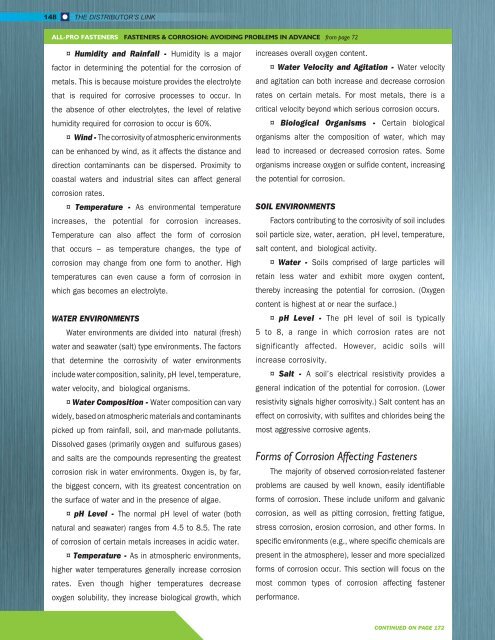WINTER 2021
Distributor's Link Magazine Fall 2020 / Vol 44 No 1
Distributor's Link Magazine Fall 2020 / Vol 44 No 1
Create successful ePaper yourself
Turn your PDF publications into a flip-book with our unique Google optimized e-Paper software.
148<br />
THE DISTRIBUTOR’S LINK<br />
ALL-PRO FASTENERS FASTENERS & CORROSION: AVOIDING PROBLEMS IN ADVANCE from page 72<br />
¤ Humidity and Rainfall - Humidity is a major<br />
factor in determining the potential for the corrosion of<br />
metals. This is because moisture provides the electrolyte<br />
that is required for corrosive processes to occur. In<br />
the absence of other electrolytes, the level of relative<br />
humidity required for corrosion to occur is 60%.<br />
¤ Wind - The corrosivity of atmospheric environments<br />
can be enhanced by wind, as it affects the distance and<br />
direction contaminants can be dispersed. Proximity to<br />
coastal waters and industrial sites can affect general<br />
corrosion rates.<br />
¤ Temperature - As environmental temperature<br />
increases, the potential for corrosion increases.<br />
Temperature can also affect the form of corrosion<br />
that occurs – as temperature changes, the type of<br />
corrosion may change from one form to another. High<br />
temperatures can even cause a form of corrosion in<br />
which gas becomes an electrolyte.<br />
WATER ENVIRONMENTS<br />
Water environments are divided into natural (fresh)<br />
water and seawater (salt) type environments. The factors<br />
that determine the corrosivity of water environments<br />
include water composition, salinity, pH level, temperature,<br />
water velocity, and biological organisms.<br />
¤ Water Composition - Water composition can vary<br />
widely, based on atmospheric materials and contaminants<br />
picked up from rainfall, soil, and man-made pollutants.<br />
Dissolved gases (primarily oxygen and sulfurous gases)<br />
and salts are the compounds representing the greatest<br />
corrosion risk in water environments. Oxygen is, by far,<br />
the biggest concern, with its greatest concentration on<br />
the surface of water and in the presence of algae.<br />
¤ pH Level - The normal pH level of water (both<br />
natural and seawater) ranges from 4.5 to 8.5. The rate<br />
of corrosion of certain metals increases in acidic water.<br />
¤ Temperature - As in atmospheric environments,<br />
higher water temperatures generally increase corrosion<br />
rates. Even though higher temperatures decrease<br />
oxygen solubility, they increase biological growth, which<br />
increases overall oxygen content.<br />
¤ Water Velocity and Agitation - Water velocity<br />
and agitation can both increase and decrease corrosion<br />
rates on certain metals. For most metals, there is a<br />
critical velocity beyond which serious corrosion occurs.<br />
¤ Biological Organisms - Certain biological<br />
organisms alter the composition of water, which may<br />
lead to increased or decreased corrosion rates. Some<br />
organisms increase oxygen or sulfide content, increasing<br />
the potential for corrosion.<br />
SOIL ENVIRONMENTS<br />
Factors contributing to the corrosivity of soil includes<br />
soil particle size, water, aeration, pH level, temperature,<br />
salt content, and biological activity.<br />
¤ Water - Soils comprised of large particles will<br />
retain less water and exhibit more oxygen content,<br />
thereby increasing the potential for corrosion. (Oxygen<br />
content is highest at or near the surface.)<br />
¤ pH Level - The pH level of soil is typically<br />
5 to 8, a range in which corrosion rates are not<br />
significantly affected. However, acidic soils will<br />
increase corrosivity.<br />
¤ Salt - A soil’s electrical resistivity provides a<br />
general indication of the potential for corrosion. (Lower<br />
resistivity signals higher corrosivity.) Salt content has an<br />
effect on corrosivity, with sulfites and chlorides being the<br />
most aggressive corrosive agents.<br />
Forms of Corrosion Affecting Fasteners<br />
The majority of observed corrosion-related fastener<br />
problems are caused by well known, easily identifiable<br />
forms of corrosion. These include uniform and galvanic<br />
corrosion, as well as pitting corrosion, fretting fatigue,<br />
stress corrosion, erosion corrosion, and other forms. In<br />
specific environments (e.g., where specific chemicals are<br />
present in the atmosphere), lesser and more specialized<br />
forms of corrosion occur. This section will focus on the<br />
most common types of corrosion affecting fastener<br />
performance.<br />
CONTINUED ON PAGE 172
















